A Systematic Review of the Potential Influence of Urbanization on the Regional Thunderstorm Process and Lightning Activity
Abstract
1. Introduction
2. The Method Involving the Lighting Location and Experimentation
3. The Lightning Hazard and Its Spatial and Temporal Activity Characteristics
4. Impact of Aerosols on Thunderstorm Processes and Lightning Activity
5. Influence of Urban Thermal Effect on Thunderstorm Processes and Lightning Activity
6. Influence of Urban Dynamic Effect on Thunderstorm Processes and Lightning Activity
7. Influence of Tall Structures on Atmospheric Electrical Activity
8. Conclusions
- (1)
- How to analyze comprehensively the spatiotemporal patterns of urban lightning activity under different thunderstorm intensity backgrounds?
- (2)
- How to conduct analysis to investigate the influence of alterations in the boundary layer structure, water–heat energy balance, and water vapor circulation processes on urban lightning activity in the context of urbanization?
- (3)
- How to couple numerical models of different scales to enhance the understanding of the impact of complex underlying surfaces on urban lightning activity?
Author Contributions
Funding
Institutional Review Board Statement
Informed Consent Statement
Data Availability Statement
Conflicts of Interest
References
- Richard, E.O.; Gary, R.H.; William, R.B.; Kenneth, C.L. The north American lightning detection network (NALDN) analysis of flash data: 2001–2009. Mon. Weather. Rev. 2011, 139, 1305–1322. [Google Scholar] [CrossRef]
- Scott, D.R.; Peterson, M.J.; Kahn, D.T. GLD360 Performance Relative to TRMM LIS. J. Atmos. Ocean. Technol. 2017, 34, 1307–1322. [Google Scholar] [CrossRef]
- Hui, W.; Huang, F.; Guo, Q. Combined application of lightning detection data from satellite and ground-based observations. Opt. Precis. Eng. 2018, 26, 218–229. (In Chinese) [Google Scholar] [CrossRef]
- Shepherd, J.M. A review of current investigations of urban-induced rainfall and recommendations for the future. Earth Interact. 2005, 9, 1–27. [Google Scholar] [CrossRef]
- Wang, Q.; Li, Z.; Guo, J.; Zhao, C.; Cribb, M. The climate impact of aerosols on the lightning flash rate: Is it detectable from long-term measurements? Atmos. Chem. Phys. 2018, 18, 12797–12816. [Google Scholar] [CrossRef]
- Yue, C.; Tang, Y.; Gu, W.; Han, Z.; Wang, X. Study of Urban Barrier Effect on Local Typhoon Precipitation. Meteorol. Mon. 2019, 45, 1611–1620. (In Chinese) [Google Scholar] [CrossRef]
- Wang, Y.; Lu, G.; Shi, T.; Ma, M.; Wang, Y. Enhancement of cloud-to-ground lightning activity caused by the urban effect: A case study in the Beijing metropolitan area. Remote Sens. 2021, 13, 1228. [Google Scholar] [CrossRef]
- Shi, T.; Yang, Y.; Zheng, Z.; Tian, Y.; Huang, Y.; Lu, Y.; Shi, C.; Liu, L.; Zi, Y.; Wang, Y.; et al. Potential urban barrier effect to alter patterns of cloud-to-ground lightning in Beijing metropolis. Geophys. Res. Lett. 2022, 49, e2022GL100081. [Google Scholar] [CrossRef]
- Farias, W.R.G.; Pinto, O., Jr.; Naccarato, K.P.; Pinto, I.R.C.A. Anomalous lightning activity over the Metropolitan Region of São Paulo due to urban effects. Atmos. Res. 2008, 91, 485–490. [Google Scholar] [CrossRef]
- del Río, D.; Younes, C.; Pulgarín, J. Lightning activity behavior over Bogota-Colombia due to urban effect. In Proceedings of the International Symposium on Lightning Protection, Balneario Camboriu, Brazil, 28 September–2 October 2015; pp. 270–274. [Google Scholar]
- Tan, Y.; Ma, X.; Xiang, C.; Xia, Y.; Zhang, X. A numerical study of the effects of aerosol on electrification and lightning discharges during thunderstorms. Chin. J. Geophys. 2017, 60, 3041–3051. [Google Scholar] [CrossRef]
- Sun, X.; Luo, Y.; Gao, X.; Wu, M.; Xu, H. On the localized extreme rainfall over the Great Bay Area in south China with complex topography and strong UHI effects. Mon. Weather. Rev. 2021, 149, 2777–2801. [Google Scholar] [CrossRef]
- Altaratz, O.; Koren, I.; Yair, Y.; Price, C. Lightning response to smoke from Amazonian fires. Geophys. Res. Lett. 2010, 37, L07801. [Google Scholar] [CrossRef]
- Zhang, C.; Chen, F.; Miao, S.; Li, Q.; Xia, X.; Xuan, C. Impacts of urban expansion and future green planting on summer precipitation in the Beijing metropolitan area. J. Geophys. Res. Atmos. 2009, 114, D02116. [Google Scholar] [CrossRef]
- Xu, R.; Miao, J.; Tan, Z. Numerical Simulation of the Impact of Urban Underlying Surface Characteristics on Thunderstorm in Nanjing. Chin. J. Atmos. Sci. 2013, 37, 1235–1246. (In Chinese) [Google Scholar]
- Liu, J.; Niyogi, D. Meta-analysis of urbanization impact on rainfall modification. Sci. Rep. 2019, 9, 7301. [Google Scholar] [CrossRef] [PubMed]
- Westcott, N.E. Summertime cloud-to-ground lightning activity around major midwestern urban areas. J. Appl. Meteorol. 1995, 34, 1633–1642. [Google Scholar] [CrossRef]
- Craig, K.; Bornstein, R. MM5 simulations of urban induced convective precipitation over Atlanta. Preprints. In Proceedings of the Fourth Conference on the Urban Environment, Norfolk, VA, USA, 20–24 May 2002; Volume 1, p. 3. [Google Scholar]
- Thielen, J.; Wobrock, W.; Gadian, A.; Mestayer, P.; Creutin, J. The possible influence of urban surfaces on rainfall development: A sensitivity study in 2D in the meso-γ-scale. Atmos. Res. 2000, 54, 15–39. [Google Scholar] [CrossRef]
- Luo, Y.; Wu, M.; Ren, F. Seasonality and synoptic situations of extreme hourly precipitation over China. J. Clim. 2016, 29, 8703–8719. [Google Scholar] [CrossRef]
- Liu, X.; Hu, F.; Li, L.; Wang, Y. Summer urban climate trends and environmental effect in the Beijing area. Chin. J. Geophys. 2006, 49, 689–697. (In Chinese) [Google Scholar] [CrossRef]
- Zhu, X.; Zhang, Y.; Xu, F. A Review of Effects of Oceans and Urbanization on the Characteristics of Thunderstorms in China. J. Guangdong Ocean. Univ. 2015, 1, 109–114. (In Chinese) [Google Scholar] [CrossRef]
- Meng, W.; Yan, J.; Hu, H. Possible Impact of Urbanization on Severe Thunderstorms over Pearl River Delta. Chin. J. Atmos. Sci. 2007, 31, 364–376. (In Chinese) [Google Scholar]
- Yin, J.; Zhang, D.L.; Luo, Y.; Ma, R. On the extreme rainfall event of 7 May 2017 over the coastal city of Guangzhou. Part I: Impacts of urbanization and orography. Mon. Weather. Rev. 2020, 148, 955–979. [Google Scholar] [CrossRef]
- Cotton, W.R.; PieIke, R.A. Human Impacts on Weather and Climate: Inadvertent Human Impacts on Regional Weather and Climate; Cambridge University Press: Cambridge, UK, 2007; pp. 148–187. [Google Scholar]
- Yang, L.; Li, Q.; Yuan, H.; Ma, R. Impacts of urban canopy on two convective storms with contrasting synoptic conditions over Nanjing, China. J. Geophys. Res. Atmos. 2021, 126, e2020JD034509. [Google Scholar] [CrossRef]
- Bornstein, R.; LeRoy, M. Urban barrier effects on convective and frontal thunderstorms. Preprints. In Proceedings of the Fourth AMS Conference on Mesoscale Processes, Boulder, CO, USA, 25–29 June 1990; pp. 120–121. [Google Scholar]
- Stallins, J.A.; Bentley, M.L. Urban lightning climatology and GIS: An analytical framework from the case study of Atlanta, Georgia. Appl. Geogr. 2006, 26, 242–259. [Google Scholar] [CrossRef]
- Brown, M.E.; Arnold, D.L. Land-surface-atmosphere interactions associated with deep convection in Illinois. Int. J. Climatol. 2015, 18, 1637–1653. [Google Scholar] [CrossRef]
- Dou, J.; Wang, Y.; Bornstein, R.; Miao, S. Observed spatial characteristics of Beijing urban climate impacts on summer thunderstorms. J. Appl. Meteorol. Sci. 2015, 54, 94–105. [Google Scholar] [CrossRef]
- Dixon, P.G.; Mote, T.L. Patterns and causes of Atlantas urban heat island-initiated precipitation. J. Appl. Meteorol. 2003, 42, 1273–1284. [Google Scholar] [CrossRef]
- Soriano, L.R.; de Pablo, F. Effect of small urban areas in central Spain on the enhancement of cloud-to-ground lightning activity. Atmos. Environ. 2002, 36, 2809–2816. [Google Scholar] [CrossRef]
- Schmid, P.E.; Niyogi, D. Impact of city size on precipitation-modifying potential. Geophys. Res. Lett. 2013, 40, 5263–5267. [Google Scholar] [CrossRef]
- Kingfield, D.M.; Calhoun, K.M.; de Beurs, K.M.; Henebry, G.M. Effects of city size on thunderstorm evolution revealed through a multiradar climatology of the central United States. J. Appl. Meteorol. Climatol. 2018, 57, 295–317. [Google Scholar] [CrossRef]
- Jiang, R.; Qie, X.; Li, Z.; Zhang, H.; Lv, G. Luminous crown residual vs. bright space segment: Characteristical structures for the intermittent positive and negative leaders of triggered lightning. Geophys. Res. Lett. 2020, 47, e2020GL088107. [Google Scholar] [CrossRef]
- Zheng, D.; Meng, Q.; Lv, W.; Zhang, Y. Spatial and temporal characteristics of cloud-to-ground lightning in summer in Beijing and its circumjacent regions. J. Appl. Meteorol. Sci. 2005, 16, 638–644. (In Chinese) [Google Scholar] [CrossRef]
- Li, R.; Lu, X.; Zhang, H.; Zhang, Y. Temporal and Spatial Distribution Characteristics of Cloud-to-ground Flash from 2008 to 2010 in Beijing. Meteorol. Environ. Sci. 2013, 36, 52–56. (In Chinese) [Google Scholar] [CrossRef]
- Wu, F.; Cui, X.; Zhang, D.; Liu, D.; Zheng, D.; Wu, F.; Cui, C.; Zhang, D.; Liu, D.; Zheng, D. SAFIR-3000 lightning statistics over the Beijing metropolitan region during 2005–2007. J. Appl. Meteorol. Climatol. 2016, 55, 2613–2633. [Google Scholar] [CrossRef]
- Wang, D.; Qie, X.; Yuan, S.; Sun, Z.; Chen, Z.; Li, J.; Zhang, H.; Liu, M.; Srivastava, A.; Liu, D. Spatial and Temporal Distribution of Lightning Activity and Contribution of Thunderstorms with Different Lightning-Producing Capabilities in Beijing Metropolitan Region. Chin. J. Atmos. Sci. 2020, 44, 225–238. (In Chinese) [Google Scholar]
- Qie, X.; Yuan, S.; Chen, Z.; Wang, D.; Liu, D.; Sun, M.; Sun, Z.; Srivastava, A.; Zhang, H.; Lu, J. Understanding the dynamical-microphysical-electrical processes associated with severe thunderstorms over the Beijing metropolitan region. Sci. China Earth Sci. 2021, 64, 10–26. [Google Scholar] [CrossRef]
- Meng, Q.; Lv, W.; Yao, W. Application of Detection Data from Electric Field Meter on Ground to Lightning Warning Technique. Meteorol. Mon. 2005, 9, 30–33. [Google Scholar] [CrossRef]
- Zhang, Y.; Zhou, X. Review and Progress of Lightning Research. J. Appl. Meteorol. Sci. 2006, 17, 829–834. [Google Scholar] [CrossRef]
- Qie, X.; Zhang, Q.; Yuan, T.; Zhang, Y. Lightning Physics; Science Press: Beijing, China, 2013. [Google Scholar]
- Shi, T.; Lu, G.; Fan, Y.; Li, X.; Zhang, Y. A comprehensive study on the improved radio-frequency magnetic field measurement for the initial upward leader of a negative rocket-triggered lightning flash. Remote Sens. 2021, 13, 1533. [Google Scholar] [CrossRef]
- Orville, R.E.; Huffines, G.R. Lightning ground flash measurements over the contiguous United States: 1995\u201397s. Mon. Weather. Rev. 1999, 127, 2693–2703. [Google Scholar] [CrossRef]
- Zhu, J. Comparison of the satellite-based Lightning Imaging Sensor (LIS) against the ground-based national lightning monitoring network. Prog. Geophys. 2018, 33, 1–6. [Google Scholar] [CrossRef]
- Gu, S.; Wang, J.; Feng, W.; Wang, P.; Guo, J. Statistical and Mining Analysis of Lightning Detection Data in Power Grid. High Volt. Eng. 2016, 42, 3383–3391. [Google Scholar] [CrossRef]
- Chen, L.; Zhang, Y.; Lu, W.; Zheng, D.; Zhang, Y.; Chen, S.; Huang, Z. Performance Evaluation for a Lightning Location System Based on Observations of Artificially Triggered Lightning and Natural Lightning lightning. J. Atmos. Ocean. Technol. 2012, 29, 1835–1844. [Google Scholar] [CrossRef]
- Biagi, C.J.; Uman, M.A.; Hill, J.D.; Jordan, D.M. Observations of the initial, upward-propagating, positive leader steps in a rocket-and-wire triggered lightning discharge. Geophys. Res. Lett. 2010, 38, L24809. [Google Scholar] [CrossRef]
- Biagi, C.J.; Uman, M.A.; Hill, J.D.; Rakov, V.A.; Jordan, D.M. Transient current pulses in rocket-extended wires used to trigger lightning. J. Geophys. Res. 2012, 117, D07205. [Google Scholar] [CrossRef]
- Qie, X.; Yang, J.; Jiang, R.; Wang, J.; Liu, D.; Wang, C.; Xuan, Y. A new-model rocket for artificially triggering lightning and its first triggering lightning experiment. Chin. J. Atmos. Sci. 2010, 34, 937–946. (In Chinese) [Google Scholar]
- Zhang, Y.; Yang, S.; Lv, W.; Zheng, D.; Dong, W.; Li, B.; Chen, S.; Zhang, Y. Luwen Chen Experiments of artificially triggered lightning and its application in Conghua, Guangdong, China. Atmos. Res. 2014, 135–136, 330–343. [Google Scholar] [CrossRef]
- Heckman, T.M.; Baum, S.A.; Breugel, W.J.M.V.; McCarthy, P. Dynamical, physical, and chemical properties of emission-line nebulae in cooling flows. Astrophys. J. 1989, 338, 48–77. [Google Scholar] [CrossRef]
- Kasemir, H.W. A contribution to the electrostatic theory of lightning discharges. J. Geophys. Res. 1960, 65, 1873–1878. [Google Scholar] [CrossRef]
- Mazur, V.; Ruhnke, L.H. Common physical processes in natural and artificially triggered lightning. J. Geophys. Res. 1993, 98, 12913–12930. [Google Scholar] [CrossRef]
- Ruhnke, H.L.; Mazur, V. A storm electric charge model and cloud-to-ground lightning. In Proceedings of the 10th International Conference on Atmospheric Electricity, Osaka, Japan, 10–14 June 1996; pp. 192–195. [Google Scholar]
- Zheng, D.; Zhang, Y.; Lu, W.; Zhang, Y.; Dong, W.; Chen, S.; Dan, J. Characteristics of return stroke currents of classical and altitude triggered lightning in GCOELD in China. Atmos. Res. 2013, 129, 67–68. [Google Scholar] [CrossRef]
- Cai, L.; Li, J.; Wang, J.; Su, R.; Ke, Y.; Zhou, M. Differences between flashes with and without return strokes in rocket-triggered lightning. Geophys. Res. Lett. 2021, 48, 11. [Google Scholar] [CrossRef]
- Tian, D.; Niu, P. Evaluation of Lightning Disaster Risk on Gas Transmission Pipeline Project Station. Sci. Technol. Eng. 2014, 14, 115–119. [Google Scholar]
- Orville, R.E.; Huffines, G.R.; Burrows, W.R.; Holle, R.L.; Cummins, K.L. The North American Lightning Detection Network (NALDN)-First Results: 1998–2000. Mon. Weather. Rev. 2002, 130, 2098–2109. [Google Scholar] [CrossRef]
- Schulz, W.; Cummins, K.; Diendorfer, G.; Dorninger, M. Cloud-to-ground lightning in Austria: A 10-year study using data from a lightning location system. J. Geophys. Res. Space Phys. 2005, 110, D9. [Google Scholar] [CrossRef]
- Li, J.; Song, H.; Xiao, W.; Du, X.; Guo, F. Temporal-spatial characteristics of lightning over Beijing and its circumjacent regions. Trans. Atmos. Sci. 2013, 36, 235–245. (In Chinese) [Google Scholar] [CrossRef]
- Kar, S.K.; Liou, Y.-A.; Ha, K.-J. Characteristics of cloud-to-ground lightning activity over Seoul, South Korea in relation to an urban effect. Ann. Geophys. 2007, 25, 2113–2118. [Google Scholar] [CrossRef]
- Coquillat, S.; Boussaton, M.P.; Buguet, M.; Lambert, D.; Ribaud, J.F.; Berthelot, A. Lightning ground flash patterns over Paris area between 1992 and 2003: Influence of pollution? Atmos. Res. 2013, 122, 77–92. [Google Scholar] [CrossRef]
- Hu, H.; Li, J.; Pan, J. Lightning Risk Assessment and Zoning in Beijing Based on the Technology of Spatial Grids. Meteorol. Mon. 2012, 38, 1004–1011. [Google Scholar] [CrossRef]
- Ntelekos, A.A.; Smith, J.A.; Krajewski, W.F. Climatological analyses of thunderstorms and flash floods in the Baltimore metropolitan region. J. Hydrometeorol. 2006, 8, 88–101. [Google Scholar] [CrossRef]
- Qie, X.; Guo, C.; Liu, X. The characteristics of ground flash in Beijing and Lanzhou regions. Plateau Meteorol. 1990, 9, 388–394. (In Chinese) [Google Scholar]
- Cheng, P.; Zhou, X.; Zhao, P.; Liu, P. A Comparative Study on Space-time Distribution Characteristics of Lightning Flashes in Beijing and Chengdu Cities. J. Chengdu Univ. Inf. Technol. 2018, 33, 326–334. (In Chinese) [Google Scholar] [CrossRef]
- Gao, X.; Tang, M.; Zhu, D. Some thoughts on climate system and earth system. Chin. J. Geophys. 2004, 47, 364–368. [Google Scholar] [CrossRef]
- Seaman, N.L.; Ludwigu, F.L.; Donall, E.G.; Warner, T.T.; Bhumralkar, C.M. Numerical studies of urban planetary boundary layer structure under realistic conditions. J. Appl. Meteorol. 1989, 28, 760–781. [Google Scholar] [CrossRef][Green Version]
- Ulrickson, B.L. Effects of surface property variations on simulated daytime airflow over coastal southern California. Mon. Weather. Rev. 1992, 120, 2264–2279. [Google Scholar] [CrossRef]
- Zhang, R.; Wang, G.; Guo, S.; Zarnora, M.L.; Ying, Q.; Lin, Y.; Wang, W.G.; Hu, M.; Wang, Y. Formation of urban fine particulate matter. Chem. Rev. 2015, 115, 3803–3855. [Google Scholar] [CrossRef]
- Kar, S.K.; Liou, Y.-A.; Ha, K.-J. Aerosol effects on the enhancement of cloud-to-ground lightning over major urban areas of South Korea. Atmos. Res. 2009, 92, 80–87. [Google Scholar] [CrossRef]
- Del Río-Trujillo, D.F.; Younes-Velosa, C.; Pulgarín-Rivera, J.D. Lightning activity over large cities located in mountainous tropical zone and its relationship with particulate matter PM10 distribution. Bogotá City Case. Rev. Fac. Ing. Univ. Antioq. 2017, 82, 22–30. [Google Scholar] [CrossRef]
- Farias, W.; Pinto, O.; Pinto, I.; Naccarato, K. The influence of urban effect on lightning activity: Evidence of weekly cycle. Atmos. Res. 2014, 135–136, 370–373. [Google Scholar] [CrossRef]
- Lal, D.M.; Pawar, S.D. Effect of urbanization on lightning over four metropolitan cities of India. Atmos. Environ. 2011, 45, 191–196. [Google Scholar] [CrossRef]
- Rosenfeld, D.; Woodley, W.L. Deep convective clouds with sustained supercooled liquid water down to −37.5 °C. Nature 2000, 405, 440–442. [Google Scholar] [CrossRef] [PubMed]
- Naccarato, K.P.; Pinto, O.; Pinto, I.R.C.A. Evidence of thermal and aerosol effects on the clou-to-ground lightning density and polarity over large urban areas of southeastern brazil. Geophys. Res. Lett. 2003, 30, 1674–1677. [Google Scholar] [CrossRef]
- Orville, R.E.; Huffines, G.; Nielsen-Gammon, J.; Zhang, R.Y.; Ely, B.; Steiger, S.; Phillips, S.; Allen, S.; Read, W. Enhancement of cloud-to-ground lightning over Houston, Texas. Geophys. Res. Lett. 2001, 28, 2597–2600. [Google Scholar] [CrossRef]
- Yuan, T.; Remer, L.A.; Pickering, K.E.; Yu, H. Observational evidence of aerosol enhancement of lightning activity and convective invigoration. Geophys. Res. Lett. 2011, 38, 4. [Google Scholar] [CrossRef]
- Huff, F.A.; Vogle, J.L. Urban, topographic and diurnal effects on rainfall in the St. Louis region. J. Appl. Meteorol. 1978, 17, 565–577. [Google Scholar] [CrossRef]
- Changnon, S.A.; Semonin, S.G.; Auer, A.H.; Braham, R.R.; Hales, J. METROMEX: A review and summary. Meteorol. Monogr. 1981, 18, 81. [Google Scholar]
- Shepherd, J.M.; Burian, S.J. Detection of urban-induced rainfall anomalies in a major coastal city. Earth Interact. 2003, 7, 1–17. [Google Scholar] [CrossRef]
- Qian, J.; Xu, H.; Wan, Q. The Effects on Thunderstorms of the Urbanized City Group of Pearl River Delta Region. J. Trop. Meteorol. 2010, 26, 40–48. [Google Scholar] [CrossRef]
- Baik, J.J.; Kim, Y.H.; Chun, H.Y. Dry and moist convection forced by an urban heat island. J. Appl. Meteorol. 2001, 40, 1462–1475. [Google Scholar] [CrossRef]
- Weisman, M.L.; Klemp, J.B. The structure and classification of numerically simulated convective storms in directionally varying wind shears. Mon. Weather. Rev. 1984, 112, 2479–2498. [Google Scholar] [CrossRef]
- Chen, M.; Wang, Y. Numerical simulation study of interactional effects of the low-level vertical wind shear with the cold pool on a squall line evolution in North China. Acta Meteorol. Sin. 2012, 70, 16. [Google Scholar] [CrossRef]
- Sun, J.; Wang, H.; Wang, L.; Liang, F.; Kang, Y.; Jiang, X. The Role of Urban Boundary Layer in Local Convective Torrential Rain Happening in Beijing on 10 July 2004. Chin. J. Atmos. Sci. 2006, 30, 221–234. [Google Scholar]
- Sun, J.; Yang, B. Meso-β Scale Torrential Rain Affected by Topography and the Urban Circulation. Chin. J. Atmos. Sci. 2008, 32, 1352–1364. [Google Scholar]
- Zhang, X.; Chen, J.; Yu, H.; Zhao, S.; Jia, W. Study on the Micrometeorological Characteristics over the Loess Plateau under the Influence of Thunderstorm. Plateau Meteorol. 2017, 36, 384–394. [Google Scholar] [CrossRef]
- Knaff, J.A.; Seseske, S.A.; Demaria, J.L.; Demuth, J.L. On the influences of vertical wind shear on symmetric tropical cyclone structure derived from AMSU. Mon. Weather. Rev. 2004, 132, 2503–2510. [Google Scholar] [CrossRef]
- Sun, J.; He, N.; Guo, R.; Chen, M. The Configuration Change and Train Effect Mechanism of Multi-Cell Storms. Chin. J. Atmos. Sci. 2013, 37, 137–148. [Google Scholar]
- Wang, X.; Wang, Z.; Qi, Y.; Guo, H. The impact of urbanization process on winter precipitation distribution in Beijing area. Scichina 2008, 38, 1438–1443. [Google Scholar]
- Kaufmann, R.K.; Seto, K.C.; Schneider, A.; Liu, Z.; Zhou, L.; Wang, W. Climate response to rapid urban growth: Evidence of a human-induced precipitation deficit. J. Clim. 2007, 20, 2299–2306. [Google Scholar] [CrossRef]
- Dai, J.; Qin, H.; Zheng, J. Analysis of lightning activity over the Yangtze river delta using TRMM/LIS observations. J. Appl. Meteorol. Sci. 2005, 16, 728–736. [Google Scholar] [CrossRef]
- Jin, M.L.; Shepherd, J.M. Inclusion of urban lands CAPE in a climate model: How can satellite data help? Bull. Am. Meteorol. Soc. 2005, 86, 681–689. [Google Scholar] [CrossRef][Green Version]
- Zhu, Y.; Liu, H.; Shen, J.; Ji, Y. Influence of Urban Heat Island on Pollution Diffusion in Suzhou. Plateau Meteorol. 2016, 35, 1584–1594. (In Chinese) [Google Scholar] [CrossRef]
- Lorenz, J.M.; Kronenberg, R.; Bernhofer, C.; Niyogi, D. Urban rainfall modification: Observational climatology over Berlin, Germany. J. Geophys. Res. Atmos. 2019, 124, 731–746. [Google Scholar] [CrossRef]
- Niyogi, D.; Pyle, P.; Lei, M.; Arya, S.P.; Wolfe, B. Urban modification of thunderstorms: An observational storm climatology and model case study for the Indianapolis urban region. J. Appl. Meteorol. Climatol. 2011, 50, 1129–1144. [Google Scholar] [CrossRef]
- Miao, S.; Chen, F.; Li, Q.; Fan, S. Impacts of urban processes and urbanization on summer precipitation: A case study of heavy rainfall in Beijing on 1 August 2006. J. Appl. Meteorol. Climatol. 2011, 52011, 806–825. [Google Scholar] [CrossRef]
- Hand, L.M.; Shepherd, J.M. An investigation of warm-season spatial rainfall variability in Oklahoma city: Possible linkages to urbanization and prevailing wind. J. Appl. Meteorol. Climatol. 2009, 48, 251–269. [Google Scholar] [CrossRef]
- Shi, T.; Yang, Y.; Liu, L.; Tian, Y.; Zheng, Z.; Huang, Y.; Xiao, Z.; Wang, Y.; Wang, Y.; Lu, G. Spatiotemporal patterns of long series of cloud-to-ground lightning in Beijing and its cause. Urban Clim. 2023, 49, 101480. [Google Scholar] [CrossRef]
- Yi, Y.; Yang, Z.; Wan, Q. Analysis of Lightning Density in Guangzhou City. Resour. Sci. 2006, 8, 151–156. [Google Scholar] [CrossRef]
- Zhang, N.; Jiang, W.; Wang, X. A numerical simulation of the effects of urban blocks and buildings on flow characteristics. Acta Aerodyn. Sin. 2002, 20, 339–342. [Google Scholar] [CrossRef]
- Diendorfer, G.; Zhou, H.; Pichler, H.; Thottappillil, R. Review of upward positive and bipolar lightning flashes at the Gaisberg Tower. In Proceedings of the 2011 7th Asia-Pacific International Conference on Lightning, Chengdu, China, 1–4 November 2011; pp. 263–267. [Google Scholar]
- Zhou, H.; Diendorfer, G.; Thottappillil, R.; Pichler, H.; Mair, M. Characteristics of upward bipolar lightning flashes observed at the Gaisberg Tower. J. Geophys. Res. Atmos. 2011, 116, D13106. [Google Scholar] [CrossRef]
- Romero, C.; Paolone, M.; Rubinstein, M.; Rachidi, F.; Rubinstein, A.; Diendorfer, G.; Schulz, W.; Daout, B.; Kalin, A.; Zweiacker, P. A system for the measurements of lightning currents at the Säntis Tower. Electr. Power Syst. Res. 2012, 82, 34–43. [Google Scholar] [CrossRef]
- Zhou, H.; Diendorfer, G.; Thottappillil, R.; Pichler, H.; Mair, M. Characteristics of upward positive lightning flashes initiated from the Gaisberg Tower. J. Geophys. Res. Atmos. 2012, 117, D6. [Google Scholar] [CrossRef]
- Jiang, R.; Qie, X.; Wang, Z.; Zhang, H.; Lu, G.; Sun, Z.; Liu, M.; Li, X. Characteristics of lightning leader propagation and ground attachment. J. Geophys. Res. Atmos. 2015, 120, 11–988. [Google Scholar] [CrossRef]
- Wang, Z.; Qie, X.; Jiang, R.; Wang, C.; Lu, G.; Sun, Z.; Liu, M.; Pu, Y. High-speed video observation of stepwise propagation of a natural upward positive leader. J. Geophys. Res. Atmos. 2016, 121, 307–314. [Google Scholar] [CrossRef]
- Yuan, S.; Jiang, R.; Qie, X.; Wang, D.; Liu, M.; Lu, G.; Liu, D. Characteristics of upward lightning on the Beijing 325 m meteorology tower and corresponding thunderstorm conditions. J. Geophys. Res. Atmos. 2017, 122, 12093–12105. [Google Scholar] [CrossRef]
- Srivastava, A.; Jiang, R.; Yuan, S.; Qie, X.; Sun, Z. Intermittent Propagation of Upward Positive Leader Connecting a Downward Negative Leader in a Negative Cloud-to-ground Lightning. J. Geophys. Res. Atmos. 2019, 124, 13763–13776. [Google Scholar] [CrossRef]
- Armstrong, H.; Whitehead, E.R. Field and analytical studies of transmission line shielding. IEEE Trans. Power Appar. Syst. 1968, PAS–87, 270–281. [Google Scholar] [CrossRef]
- Golde, R.H. Lightning Protection; Edward Arnold: London, UK, 1973. [Google Scholar]
- Ngqungqa, S.H. A Critical Evaluation and Analysis of Methods of Determining the Number of Times that Lightning will Strike a Structure. Ph.D. Thesis, University of the Witwatersrand, Johannesburg, South Africa, 2005. [Google Scholar]
- Lv, W.; Zhang, C.; Chen, L. Comparison of the Impact of Buildings of Different Heights on Surrounding Ground Flash Activities. In Proceedings of the 15th Lightning Protection and Disaster Reduction Forum, China Meteorological Society, Zhengzhou, China, 2017. [Google Scholar]
- Chen, L. A Study on the Influence of High Buildings on Lightning Activity and Its Characteristics. Ph.D. Thesis, Nanjing University of Information Technology, Nanjing, China, 2014. [Google Scholar]
- Pu, Y.; Jiang, R.; Qie, X.; Liu, M.; Zhang, H.; Fan, Y.; Wu, X. Upward negative leaders in positive triggered lightning: Stepping and branching in the initial stage. Geophys. Res. Lett. 2017, 44, 7029–7035. [Google Scholar] [CrossRef]
- Willett, J.C.; Davis, D.A.; Laroche, P. An experimental study of positive leaders initiating rocket-triggered lightning. Atmos. Res. 1999, 51, 189–219. [Google Scholar] [CrossRef]
- Qian, Y. Observation and Research on Artificial Triggering of Lightning Upward Leading. Master’s Thesis, Chengdu University of Information Technology, Chengdu, China, 2016. [Google Scholar]
- Lalande, P.; Bondiou-Clergerie, A.; Laroche, P.; Eybert-Berard, A.; Berlandis, J.-P.; Bador, B.; Bonamy, A.; Uman, M.A.; Rakov, V.A. Leader properties determined with triggered lightning techniques. J. Geophys. Res. Atmos. 1998, 103, 14109–14115. [Google Scholar] [CrossRef]

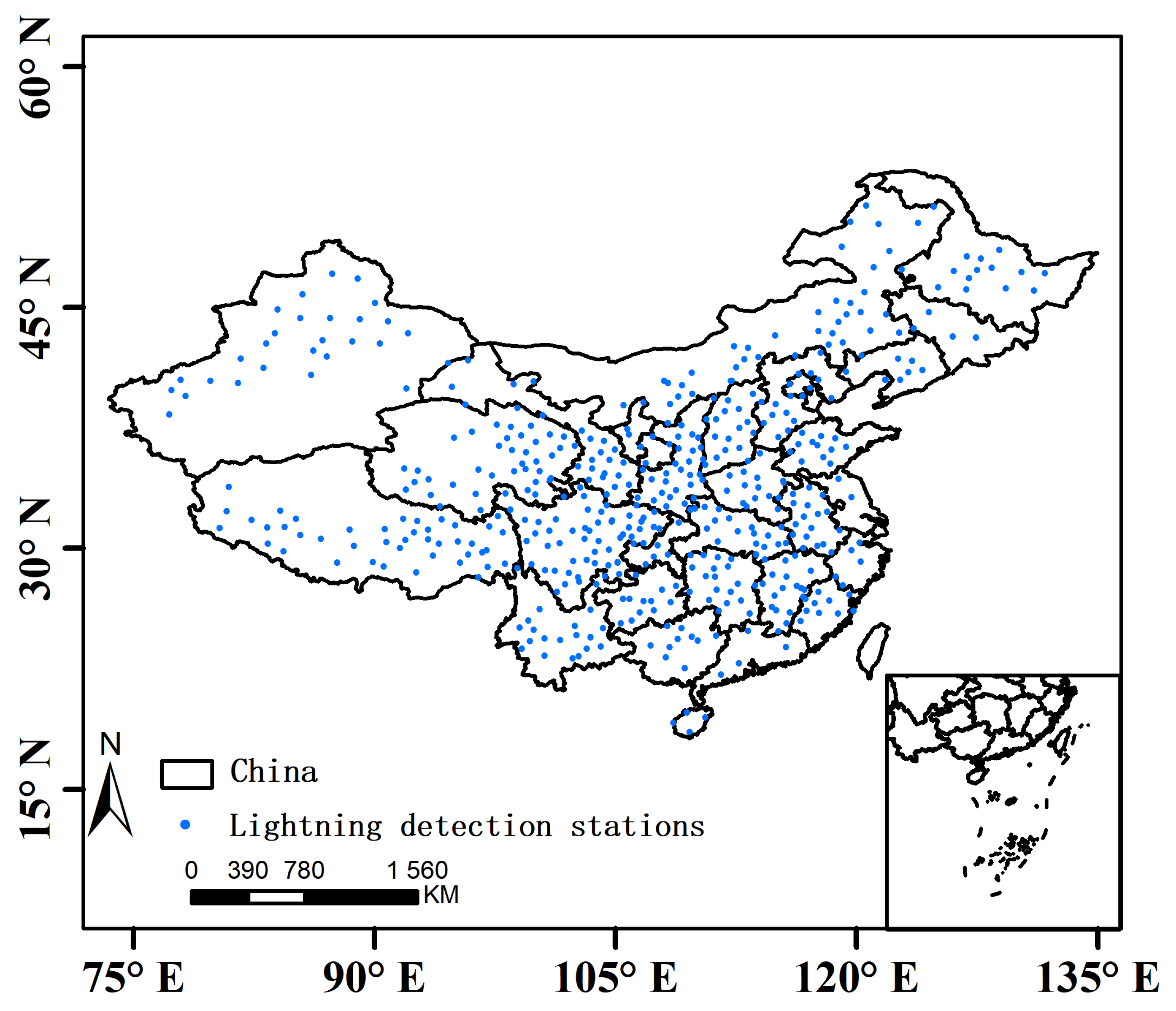

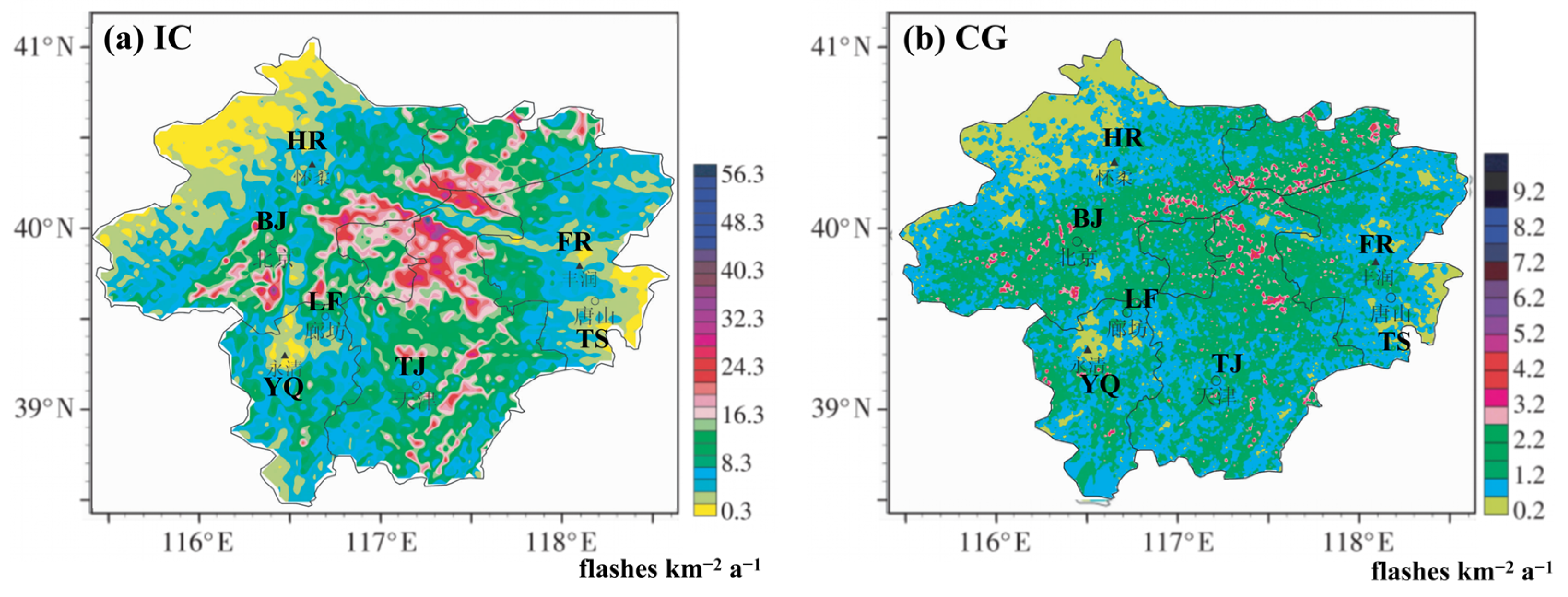
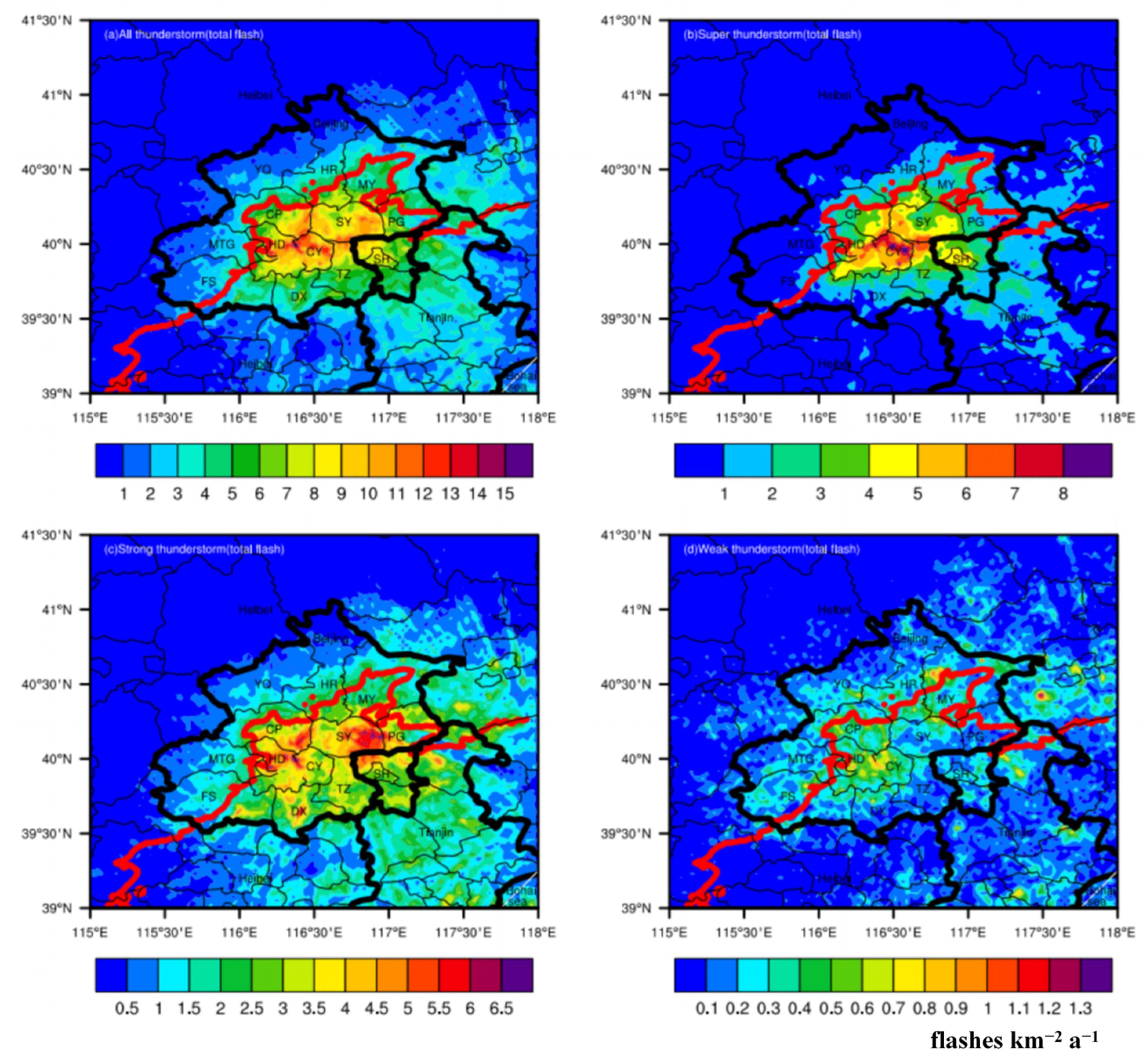
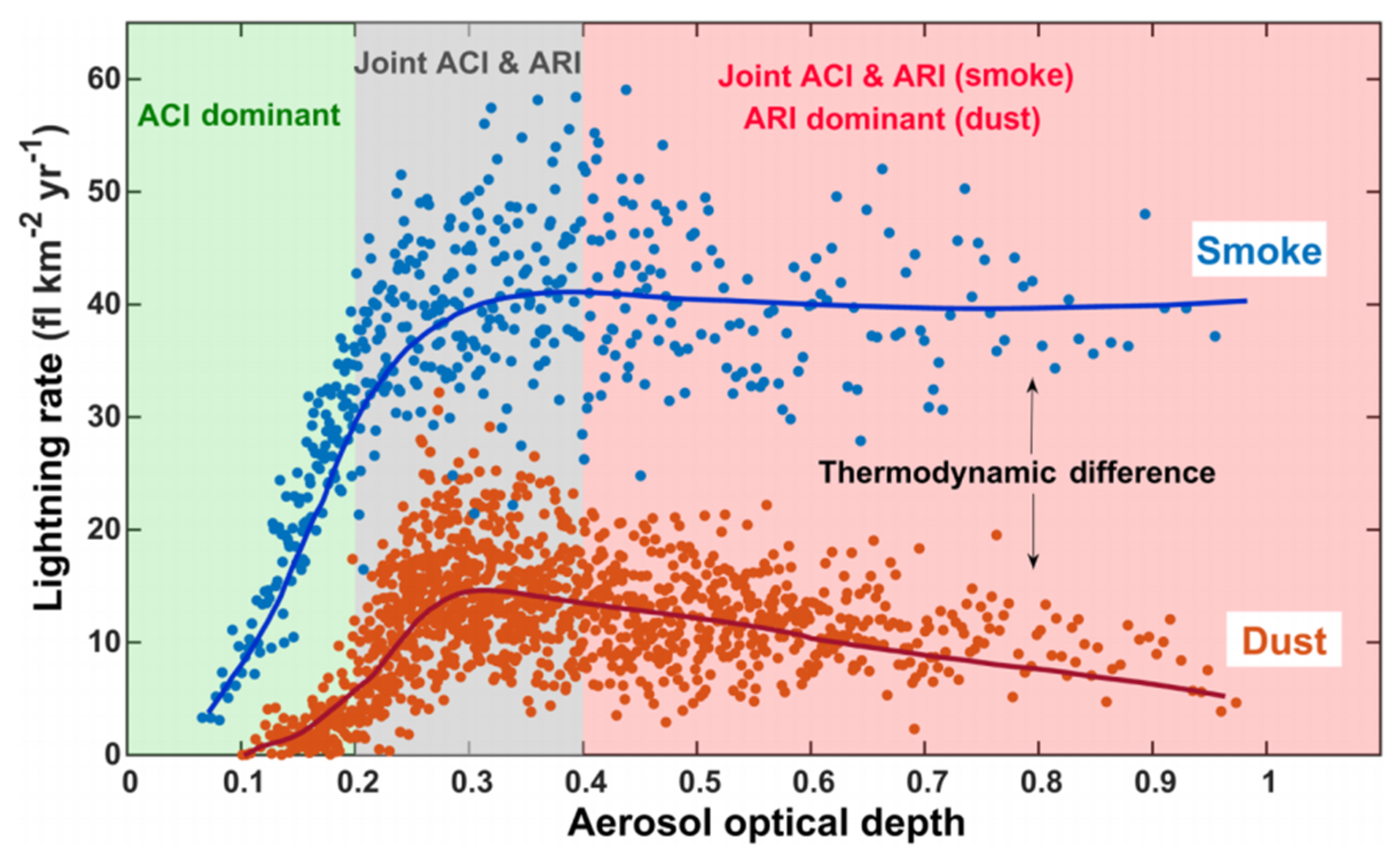
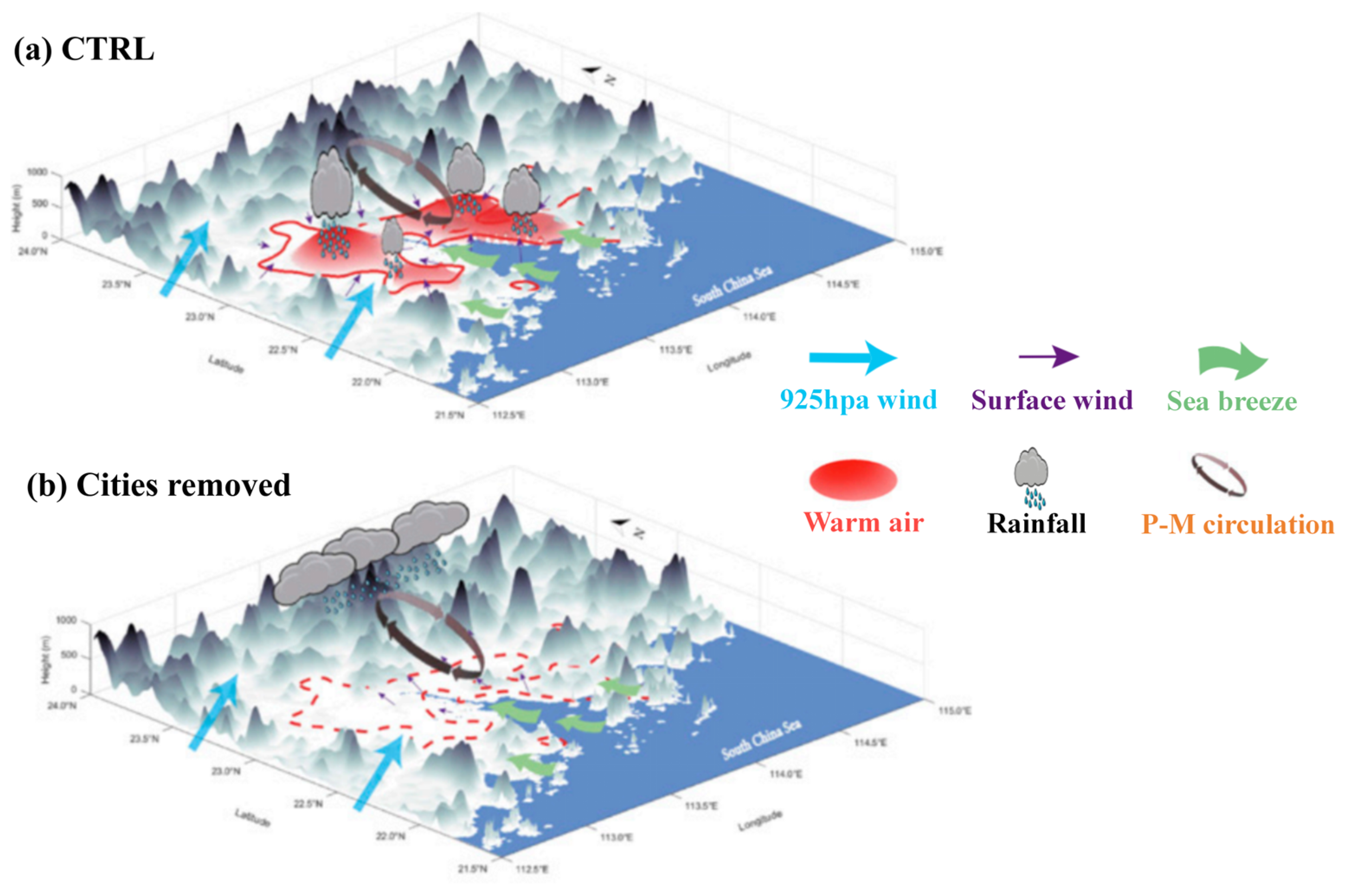

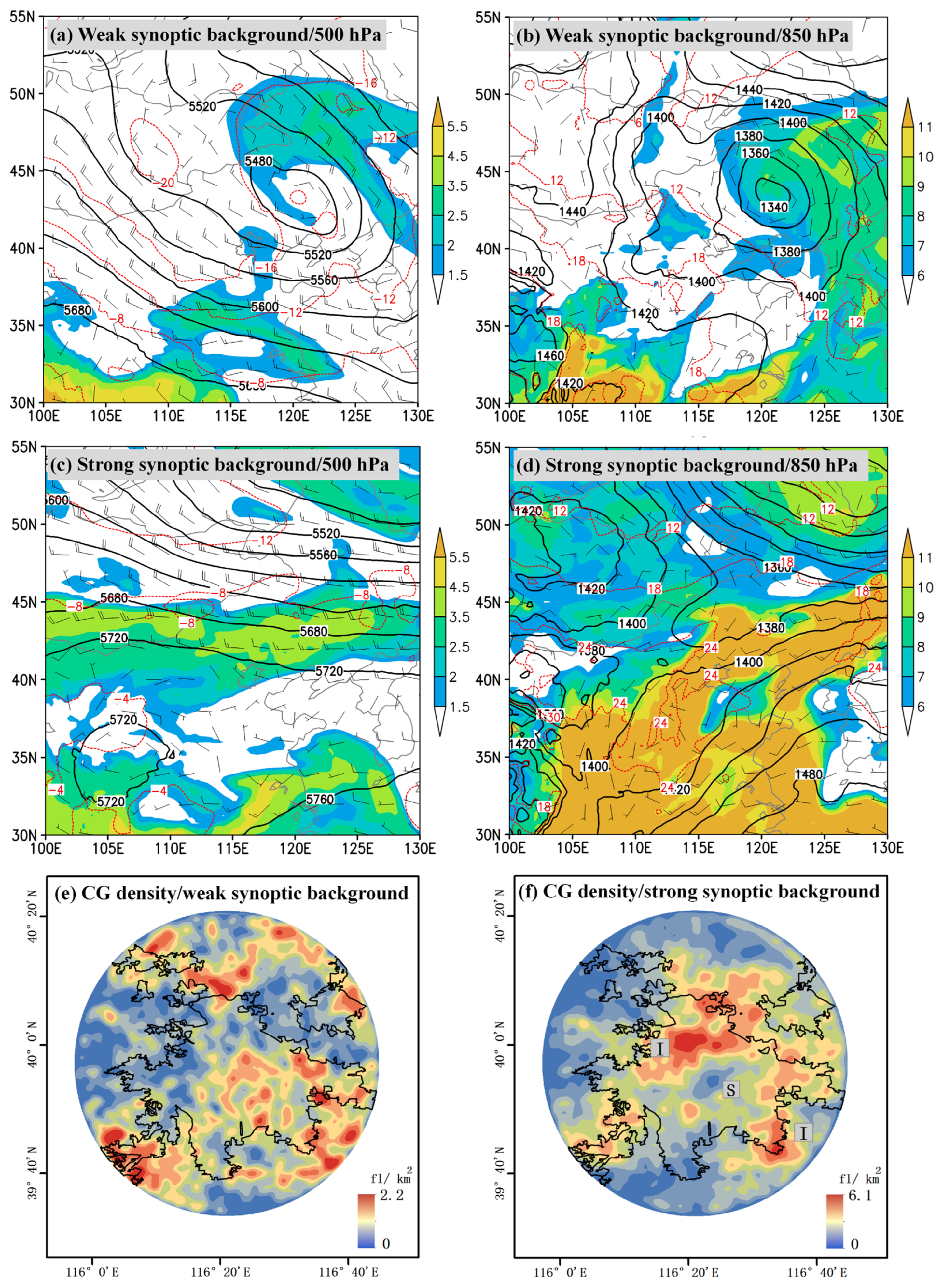
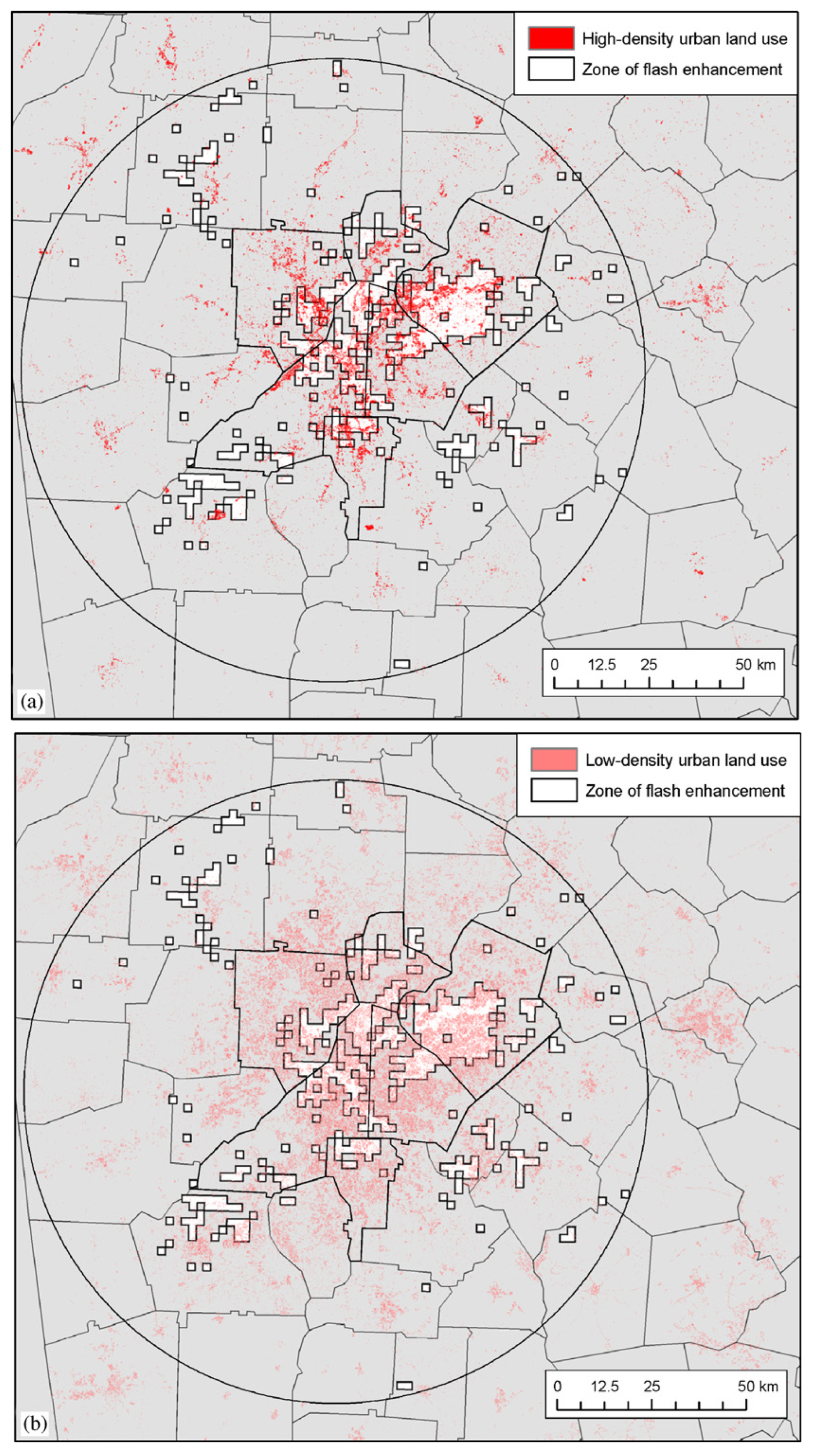



Disclaimer/Publisher’s Note: The statements, opinions and data contained in all publications are solely those of the individual author(s) and contributor(s) and not of MDPI and/or the editor(s). MDPI and/or the editor(s) disclaim responsibility for any injury to people or property resulting from any ideas, methods, instructions or products referred to in the content. |
© 2024 by the authors. Licensee MDPI, Basel, Switzerland. This article is an open access article distributed under the terms and conditions of the Creative Commons Attribution (CC BY) license (https://creativecommons.org/licenses/by/4.0/).
Share and Cite
Shi, T.; Lu, G.; Wen, X.; Liu, L.; Qi, P. A Systematic Review of the Potential Influence of Urbanization on the Regional Thunderstorm Process and Lightning Activity. Atmosphere 2024, 15, 374. https://doi.org/10.3390/atmos15030374
Shi T, Lu G, Wen X, Liu L, Qi P. A Systematic Review of the Potential Influence of Urbanization on the Regional Thunderstorm Process and Lightning Activity. Atmosphere. 2024; 15(3):374. https://doi.org/10.3390/atmos15030374
Chicago/Turabian StyleShi, Tao, Gaopeng Lu, Xiangcheng Wen, Lei Liu, and Ping Qi. 2024. "A Systematic Review of the Potential Influence of Urbanization on the Regional Thunderstorm Process and Lightning Activity" Atmosphere 15, no. 3: 374. https://doi.org/10.3390/atmos15030374
APA StyleShi, T., Lu, G., Wen, X., Liu, L., & Qi, P. (2024). A Systematic Review of the Potential Influence of Urbanization on the Regional Thunderstorm Process and Lightning Activity. Atmosphere, 15(3), 374. https://doi.org/10.3390/atmos15030374





